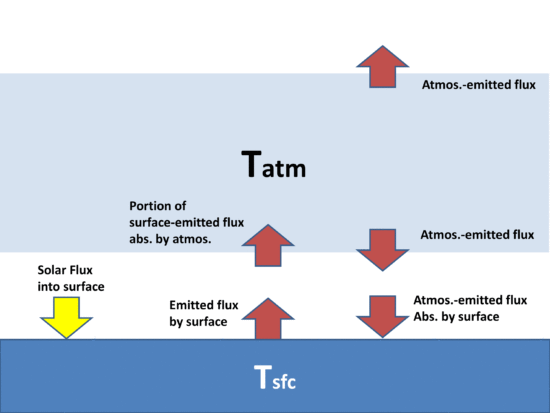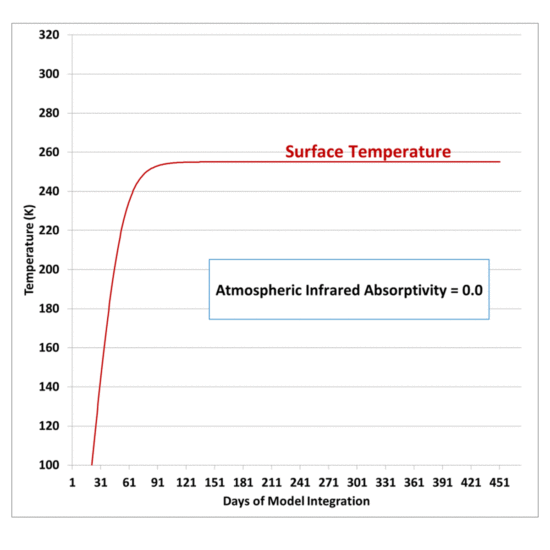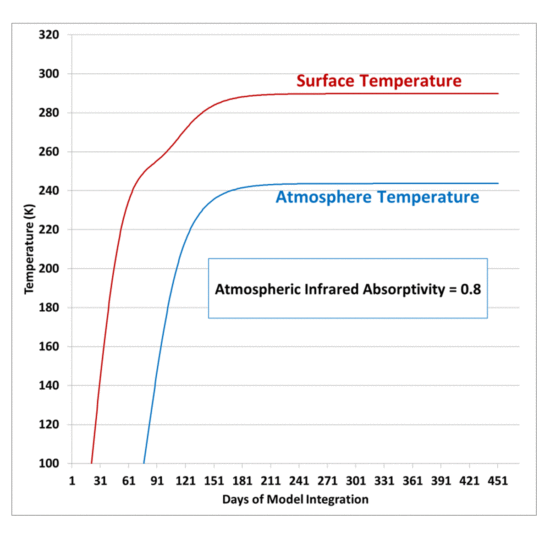I thought it would be a useful followup to post a simple time-dependent energy balance model (spreadsheet attached) to demonstrate how infrared radiative flows affect the Earth’s surface temperature and atmospheric temperature. (I might have done this before…it sounds familiar).
The model is the simplest I could come up with to demonstrate how an atmosphere that absorbs and emits IR radiation ends up warming the surface, and itself as well, while maintaining an atmospheric temperature below that of the surface.
Here are the basic energy fluxes included in the model. The illustration is just schematic.

Fig. 1 Cartoon representation of the energy flows in the simple time-dependent energy balance model of the climate system
The energy input from the sun is fixed at an assumed 240 Watts per sq. meter. The radiative fluxes use the Stefan-Boltzmann equation (sigma T^^4), where T is either the surface or atmospheric temperature. Surface emissivity is assumed to be 1 (changing it to 0.95 or less make no difference to the conclusions, only the details).
You can adjust the IR absorptivity of the model in the spreadsheet, which is just a multiplier on the radiative flux coming from the atmosphere, and the radiative flux coming up from the surface and being absorbed by the atmosphere.
The model is initialized at absolute zero Kelvin, and heat capacities are prescribed so you can see the temperature changing over time as the model goes toward energy equilibrium. The heat capacity of the surface and atmosphere are assumed to be the same, equivalent to 1 meter of water for simplicity (the atmosphere is really more like 2 m of water effective heat capacity).
Using “0” for the atmospheric absorptivity leads to a surface temperature of 255 K, and zero atmospheric temperature (the model is radiative only, no convection, no conduction, so without any atmospheric absorption of radiation, the atmosphere cannot warm):
Then, to see how this “no-atmosphere” earth changes with an atmosphere that absorbs and emits IR, an IR absorptivity of 0.8 gives a surface temperature close to 290 K, and an atmospheric temperature of about 244 K.
If the model had dozens of atmospheric layers all interacting, it would produce much higher surface temperatures, and much lower temperatures in the upper atmosphere, producing a strongly super-adiabatic temperature profile (Manabe and Strickler, 1964). This is what causes atmospheric convection, which provides a net transport of heat from the surface to the middle and upper troposphere (not contained in this radiation-only model).
Again, this is an EXTREMELY simplified model of the effect of radiative flows on the global climate system. It is only meant to demonstrate the most basic components of the atmospheric “greenhouse effect”, which act to:
1) make the Earth’s surface warmer than it would otherwise be, and
2) keep the atmosphere cooler than the surface (since the atmosphere cools radiatively to deep space, but partially “blocks” the surface from cooling to space).
UPDATE: Based upon a few comments, it might be useful to point out:
1) the final equilibrium temperature does not depend upon the initial temperature assumed at the beginning of the model integration, it can be 0 K, 100 K, or 1,000 K.
2) the final equilibrium temperature does not depend upon the assumed heat capacities of the Earth’s surface and atmosphere…those just change how much time it takes for equilibrium to be reached.

 Home/Blog
Home/Blog





